 |
 |
 |
 |
 |
 |
Kyoraku Cup
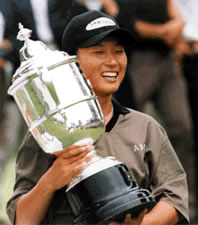 In
the past few years, much of Eastern Asia has been swept with the so called
'Korean Wave'. The popularity of Korean singers, television shows and
movies in places like Japan, China, and Vietnam has never been greater.
In fact, never before had Korean pop culture even made much of an impact
in those countries, let alone yet the explosive one it has had. Many trace
the origin of this cultural phenomenon to 2002, when Korea and Japan shared
hosting duties for Soccer's World Cup. This event introduced many countries
to Korean pop culture, and they've loved it ever since.
In
the past few years, much of Eastern Asia has been swept with the so called
'Korean Wave'. The popularity of Korean singers, television shows and
movies in places like Japan, China, and Vietnam has never been greater.
In fact, never before had Korean pop culture even made much of an impact
in those countries, let alone yet the explosive one it has had. Many trace
the origin of this cultural phenomenon to 2002, when Korea and Japan shared
hosting duties for Soccer's World Cup. This event introduced many countries
to Korean pop culture, and they've loved it ever since.
There's another Korean Wave that's been inundating not just Asia but the world, and in some ways, its origin can also be traced to around 2002. That wave is the unbelievable explosion of talented Korean women golfers popping up in recent years. Without question, the ground zero of that movement came when Se Ri Pak won the US Women's Open in 1998; that indelible moment planted the seed for everything that was to come. But the flowering of that seed into the powerful movement we see now started a few years later. Exactly when is open to debate, but by 2002, there were four world class Korean golfers on the LPGA tour, Soo-Yun Kang had conquered the KLPGA, Meena Lee was a rookie sensation over in Korea, and future LPGA Rookie of the Year Seon Hwa Lee had already won her first events as a professional.
2002 was also pivotal for Korean women's golf in another way. That year marked the return, after a one year absence, of the annual Korea-Japan team golf competition. The event had started in 1999, and the first two years, it had been dominated by the Japanese. Not surprising: the Japanese had been a golf powerhouse in Asia for decades by that point. In the late 90's, South Korea's team had the bigger stars: no Japanese player of the time could match the level of Se Ri Pak and Mi Hyun Kim, and Grace Park was preparing to join them near the top. But Japan's depth was far greater than Korea's, and that had been the difference in these events up to that point.
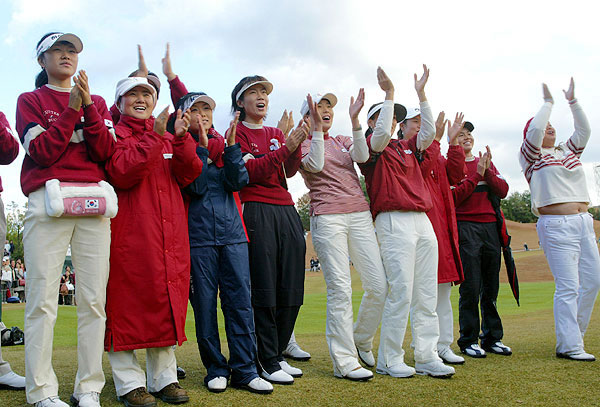 The
event was not played in 2001, but in 2002 it returned, and by that time,
everything had changed. Suddenly the Koreans were able send a remarkably
deep team to this competition, chock full of stars who had made their
mark on international golf. This powerful Korean squad defeated the Japanese
for the first time that year, and a sea change occurred that only has
accelerated in the years since. In 2003, the Koreans repeated, this time
playing in front of their home country fans in Cheju Island, Korea. In
2004, the Koreans once again took the Cup, now called the Pinx Cup, despite
the fact that two of their biggest stars, Se Ri Pak and Mi Hyun Kim, were
mired in serious slumps, and a third star, Grace Park, was only able to
play one of the two days due to sponsor commitments. By now the Koreans
team was so deep that they actually were able to win without all the possible
tournament winners they could have included on their squad. This event
was starting to become a lopsided affair, with the Koreans on their way
to a dynasty.
The
event was not played in 2001, but in 2002 it returned, and by that time,
everything had changed. Suddenly the Koreans were able send a remarkably
deep team to this competition, chock full of stars who had made their
mark on international golf. This powerful Korean squad defeated the Japanese
for the first time that year, and a sea change occurred that only has
accelerated in the years since. In 2003, the Koreans repeated, this time
playing in front of their home country fans in Cheju Island, Korea. In
2004, the Koreans once again took the Cup, now called the Pinx Cup, despite
the fact that two of their biggest stars, Se Ri Pak and Mi Hyun Kim, were
mired in serious slumps, and a third star, Grace Park, was only able to
play one of the two days due to sponsor commitments. By now the Koreans
team was so deep that they actually were able to win without all the possible
tournament winners they could have included on their squad. This event
was starting to become a lopsided affair, with the Koreans on their way
to a dynasty.
But Japanese golf also has experienced a resurgence in recent years,
and though the Koreans had won the Cup three straight years, each year
the margin of victory was becoming a little tighter. In 2004, the Japanese
actually made it pretty competitive. So there was some question about
what the outcome would be in 2005. In terms of Korean success on the world
stage, 2005 was another watershed year. Although Se Ri Pak, Mi Hyun Kim
and Grace Park all had their worst seasons to date that year, Korean golfers
still won eight tournaments on the LPGA tour, one of their best seasons
ever. Even more impressive, the wins came from eight different golfers,
several of whom had never won an event before. Many of those women played
on the 2005 Pinx Cup team. But without their top stars of years past,
and with a bizarre strategy by captain Soo-Yun Kang to randomly choose
who would play and when, the tournament proved to be quite close, and
after the first round, for the first time in years, the two teams were
tied. The next day terrible weather set in, forcing the cancellation of
the second round. The Cup was thus awarded jointly to the two teams. But
for the Korean team, coming off of three straight wins, a tie seemed like
a defeat.
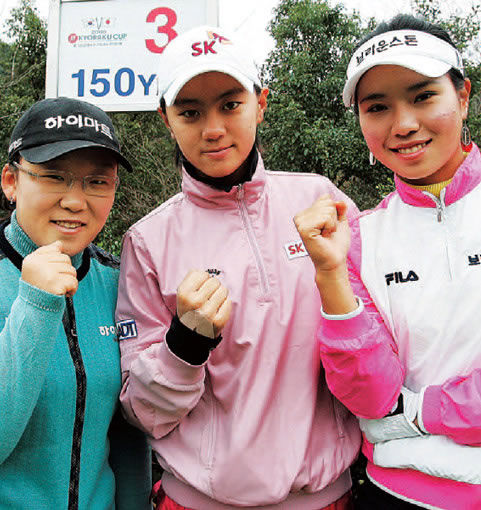 This
year, the event has undergone a slight transformation. It has a new sponsor,
and is now called the Kyoraku Cup. The media was a little bit more subdued
than in years past, although the Korean media do tend to cover the event
more thoroughly when it takes place in Korea rather than in Japan, where
this year's event took place. Also, they have changed the format. In the
past, the first round consisted of 12 match play singles matches, and
the second round was twelve stroke play matches. This year, both days
consisted of 12 stroke play singles matches. No reason was given for the
change.
This
year, the event has undergone a slight transformation. It has a new sponsor,
and is now called the Kyoraku Cup. The media was a little bit more subdued
than in years past, although the Korean media do tend to cover the event
more thoroughly when it takes place in Korea rather than in Japan, where
this year's event took place. Also, they have changed the format. In the
past, the first round consisted of 12 match play singles matches, and
the second round was twelve stroke play matches. This year, both days
consisted of 12 stroke play singles matches. No reason was given for the
change.
The Korean team was itching to get the Cup back and send a message to the Japanese that the Korean Wave was just getting started. The Japanese sent a pretty strong team this year, although two of their most famous players, Yuri Fudoh and Ai Miyazato, were mysteriously absent. Their team's best player was Shiho Ohyama, the JLPGA's leading money winner in 2006. Two strong young players, Sakura Yokomine and Shinobu Moromizato, were also headliners. The team was filled out with veteran players like Akiko Fukushima and Hiromi Mogi, who had played in several cups between them.
But despite the continued slump of star player Grace Park and the mysterious 2006 slump of last year's captain Soo-Yun Kang, the Koreans were sending one of their strongest lineups ever to the Cup this year. The captain, and amazingly the oldest player on the team, was Mi Hyun Kim, who had been the top Korean player on the LPGA money list in 2006, and who had revitalized her career with two victories on that tour this year. How things have changed! Just a few years ago, Kimmie was one of the young guns. But the average age of the Korean squad in 2006 was just under 24 years (compared to over 28 years old for the Japanese), and the team was filled with youngsters who had impressed in 2006 (this was another big change from just a few years earlier. Back then, there were several veteran Korean players in their forties on the team. Now, there was not even a player in her thirties on the squad). From the LPGA, veteran stars like Hee-Won Han and Se Ri Pak (also having a career renaissance in 2006) were joined by baby faced stars like Seon Hwa Lee, all of 20 years old and the LPGA's 2006 Rookie of the Year, and Jee Young Lee, who celebrated her 21st birthday on day one of this event. Compared to those ladies, Jeong Jang and Meena Lee, who rounded out the LPGA contingent, seemed positively ancient. Six of those seven women had won on the LPGA tour in 2006; Pak had a Major under her belt, while Han and Kim won twice. JJ only had one LPGA win, but had also collected the Japan Women's Open, beating most of the Japanese squad in one of their Majors to do it. Simply put, this was the equivalent of the 1927 Yankees staring at you from the tee box: all winners, all in the top twenty in the world, all eager to get the Cup back.
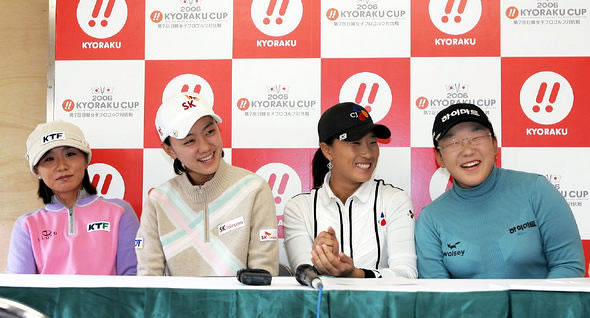
Those seven golfers were joined by three KLPGA and three JLPGA stars, and even there, the team was stocked with talent. Among the Koreans who play regularly in Japan was Jee Hee Lee, a perennial star on the JLPGA tour, and Jung Mi Jeon, who had won three times in Japan in 2006. Rounding out that contingent was Hyun Ju Shin, another top ten golfer in Japan. The KLPGA players, meanwhile, were three teenagers, but three of the most talented teens the KLPGA had ever sent to this event. Topping that group was the indescribably gifted Ji Yai Shin, who had shattered record after record in Korea in 2006 as an 18 year old phenom. Many are saying she is the most talented young golfer to come out of there since Se Ri herself; high praise indeed. Hee Young Park most years would have waltzed off with the top honors on the KLPGA. She won twice this year and has been fairly brilliant in her own right. And Na Yeon Choi, herself only nineteen, had a great season to finish third on the KLPGA money list. If the Japanese were hoping to exploit the relative weakness of the KLPGA players, they had a big surprise coming.
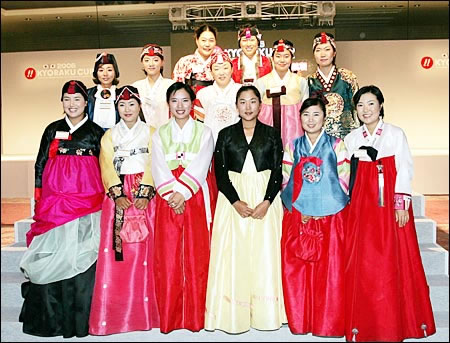 Mi
Hyun Kim was quoted in the press before the event as saying that she didn't
want a tie this year; she wanted her team to win. The Korean press gave
her the nickname 'the Japan Killer' because of her determination to bring
the Cup back to Korea. Don't let her small stature fool you: in that tiny
frame beats the heart of a lion. The nickname was indeed apt.
Mi
Hyun Kim was quoted in the press before the event as saying that she didn't
want a tie this year; she wanted her team to win. The Korean press gave
her the nickname 'the Japan Killer' because of her determination to bring
the Cup back to Korea. Don't let her small stature fool you: in that tiny
frame beats the heart of a lion. The nickname was indeed apt.
Being that this event takes place in December every year, the weather tends to be horrible. This year was no exception. At least it wasn't snowing like it did last year, but it was still cold and windy, and as a result, there were not a lot of low scores on the course.